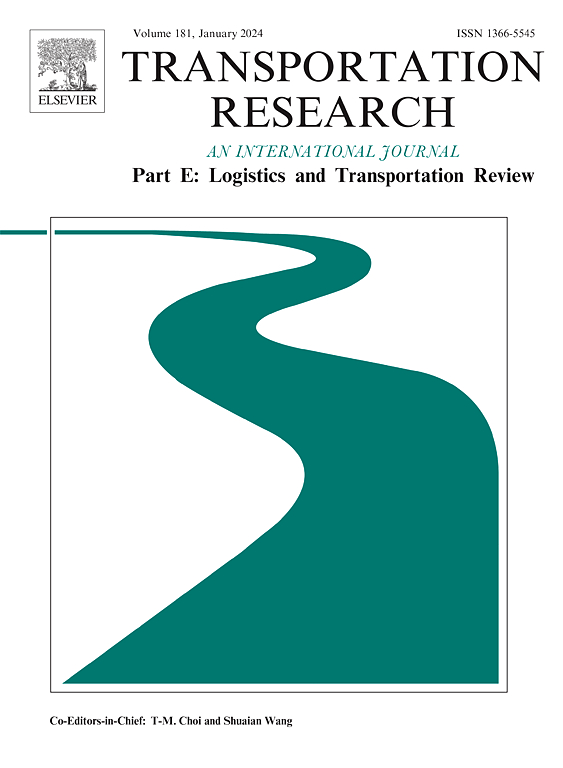面向安全的多车场车辆与人员综合调度问题
IF 8.8
1区 工程技术
Q1 ECONOMICS
Transportation Research Part E-Logistics and Transportation Review
Pub Date : 2025-08-05
DOI:10.1016/j.tre.2025.104348
引用次数: 0
摘要
公共交通运营的安全仍然是一个关键问题。目前的对策主要集中在实时预警策略上,但仍有通过重新分配车队资源来提高公交运行安全性的空间。本文引入了面向安全的多车辆段综合调度问题(S-MD-IVCSP),这是对IVCSP的一种新推广,该问题明确考虑了行程任务的安全风险。为此,我们采用生存分析模型,利用预警数据对驾驶员工作过程中的安全风险进行评估。在此基础上,建立了基于单线公交运行安全风险变化规律的安全风险转移模型,该模型可应用于区域调度下的司机跨线场景。设计了一个时空网络模型来表示S-MD-IVCSP。将驾驶员的风险概率纳入目标。为了减小车队规模、优化乘员工作时间、降低驾驶员值班风险,提出了一种多驾驶员的增强自适应大邻域搜索算法。该模型应用于中国广州的三条真实公交线路。结果表明,与传统的以成本为导向的方法相比,我们的方法可以将安全风险降低至少30%,而不会显著增加运营成本。区域调度策略与主动安全措施之间存在很强的兼容性。通过利用预警数据,区域调度可以有效降低船员的安全风险,与单线调度模式相比,安全性能提高了19%以上。我们还研究了机组人员组成和有限的驾驶员资源对整体安全性能的影响。本文章由计算机程序翻译,如有差异,请以英文原文为准。
Safety-oriented multi-depot integrated vehicle and crew scheduling problem
Safety in public transportation operations remains a critical concern. The state-of-the-practice countermeasures primarily focus on real-time warning strategies, but there is still room for improving bus operation safety through reallocating fleet resources. This study introduces the Safety-oriented Multi-depot Integrated Vehicle and Crew Scheduling Problem (S-MD-IVCSP), a new generalization to the IVCSP where the safety risks of trip tasks are explicitly considered. To this end, we use the survival analysis model to assess safety risks during drivers’ work processes using warning data. Particularly, a safety risk transition model is developed based on the changing patterns of safety risk in single-line bus operations, which can be applied to driver crossline scenarios under regional scheduling. A time-space network model is devised to represent the S-MD-IVCSP. The drivers’ risk probability is incorporated into the objective. An enhanced adaptive large neighborhood search algorithm, featuring multiple operators, is developed to reduce the fleet size, optimize crew working hours, and mitigate drivers’ duty risks. The model is applied to 3 real-world bus lines in Guangzhou, China. Results show that our approach can reduce safety risks by at least 30% compared to the traditional cost-oriented approach, without significantly increasing operational costs. There is strong compatibility between regional scheduling strategies and proactive safety measures. By leveraging the warning data, regional scheduling can reduce the crew’s safety risks effectively, improving safety performance by over 19% compared to single-line scheduling mode. We also investigate the impact of crew compositions and limited driver resources on overall safety performance.
求助全文
通过发布文献求助,成功后即可免费获取论文全文。
去求助
来源期刊
CiteScore
16.20
自引率
16.00%
发文量
285
审稿时长
62 days
期刊介绍:
Transportation Research Part E: Logistics and Transportation Review is a reputable journal that publishes high-quality articles covering a wide range of topics in the field of logistics and transportation research. The journal welcomes submissions on various subjects, including transport economics, transport infrastructure and investment appraisal, evaluation of public policies related to transportation, empirical and analytical studies of logistics management practices and performance, logistics and operations models, and logistics and supply chain management.
Part E aims to provide informative and well-researched articles that contribute to the understanding and advancement of the field. The content of the journal is complementary to other prestigious journals in transportation research, such as Transportation Research Part A: Policy and Practice, Part B: Methodological, Part C: Emerging Technologies, Part D: Transport and Environment, and Part F: Traffic Psychology and Behaviour. Together, these journals form a comprehensive and cohesive reference for current research in transportation science.

 求助内容:
求助内容: 应助结果提醒方式:
应助结果提醒方式:


